The Boat
AWARD WINNING BOAT THAT’S TWICE THE FUN
Airborne foiling or sailing with a daggerboard.
14ft
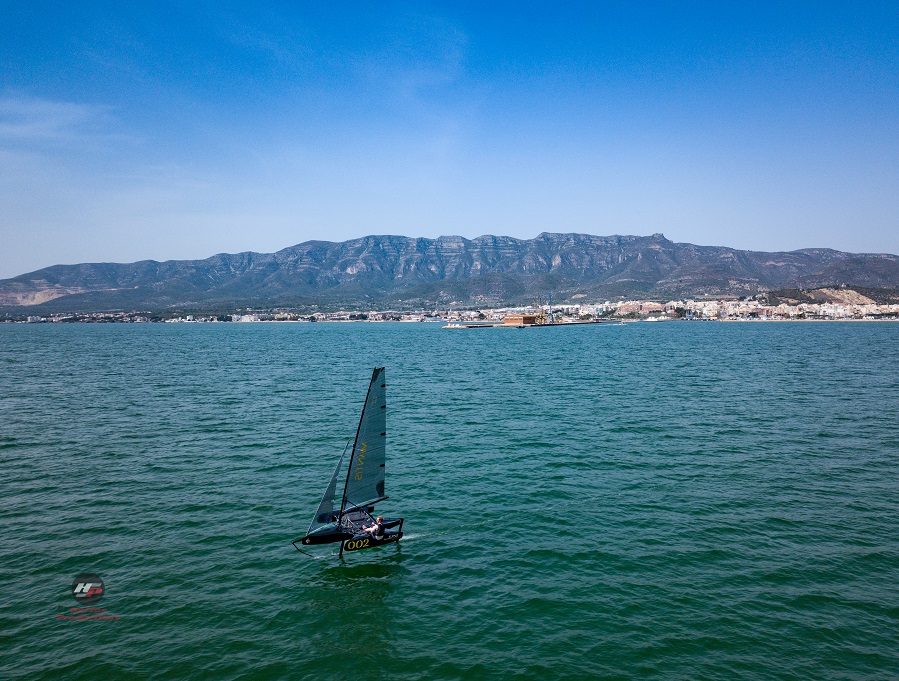
Imagine
Foiling is a sport that is here to stay. Foiling has been around for years but until now it helped to be an expert sailor and not too large if you wanted to succeed. The Flying Mantis is designed to be sailed with a conventional daggerboard that can be swapped for a central T-foil, to go foiling. Why not progress from one to the other?
…and it’s fun, even if it’s not an ideal day for foiling.
25kg
Approx central hull weight
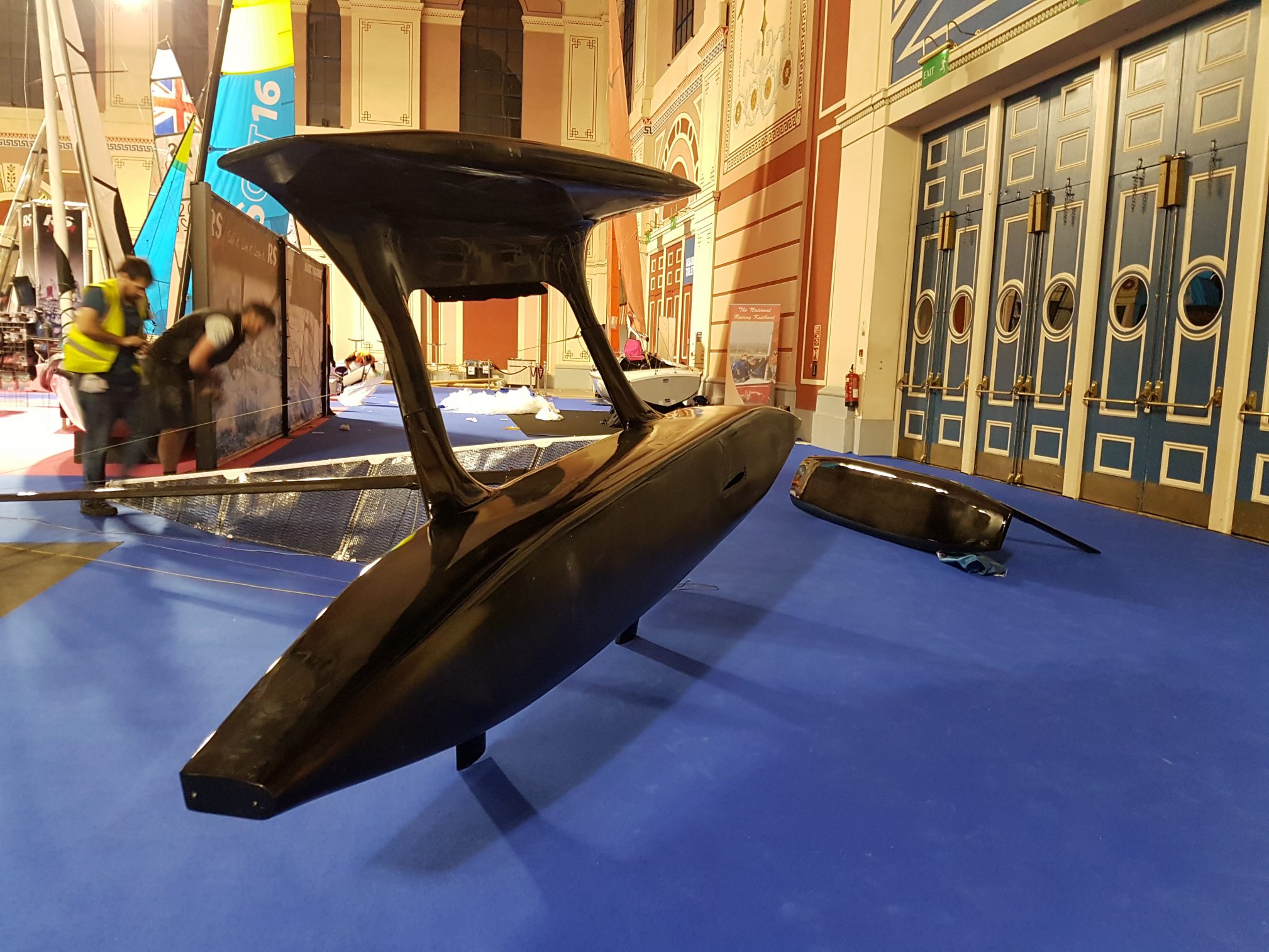
Portable
The central hull weighs around 25kg plus removable outriggers at 12.5kg each.
The Flying Mantis is designed to be rigged quickly. The outriggers can be fitted or derigged without taking down the mast. The boat can be towed behind a car with the hulls still assembled. It doesn’t need to live in a dinghy park, which makes it easier to sail somewhere different each day.
DBS
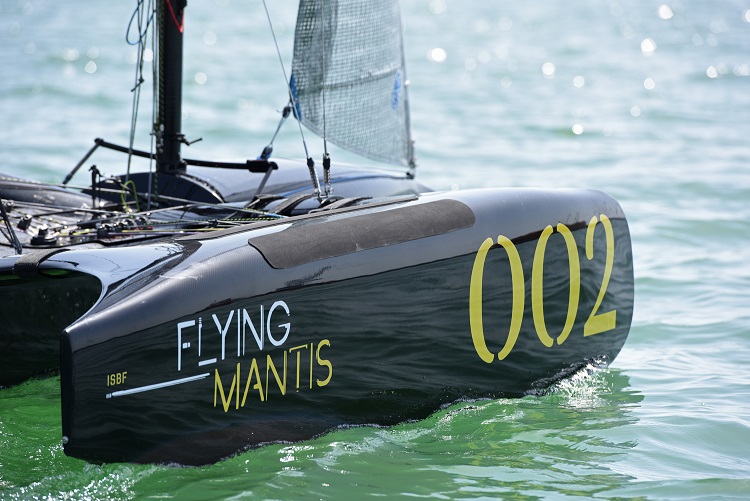
Sailing with a Daggerboard (displacement / mode archimédien)
A great boat that any sailor can enjoy. It comes with a lift-up rudder and a central daggerboard.
This boat has all the advantages of lightweight carbon hulls, mast and boom that result in high performance and forgiving multihull sailing.
Airborne Foiling
Everything from the daggerboard sailing (DBS) version but with replacement central and rudder T-foils and a foiling system that connects a control wand at the front of the bowsprit.
Designed to provide early take-off at lower boat speeds enabling more fun in lighter winds.
If the sailing conditions are not good for foiling, the Flying Mantis is still great fun as a conventional performance trimaran.
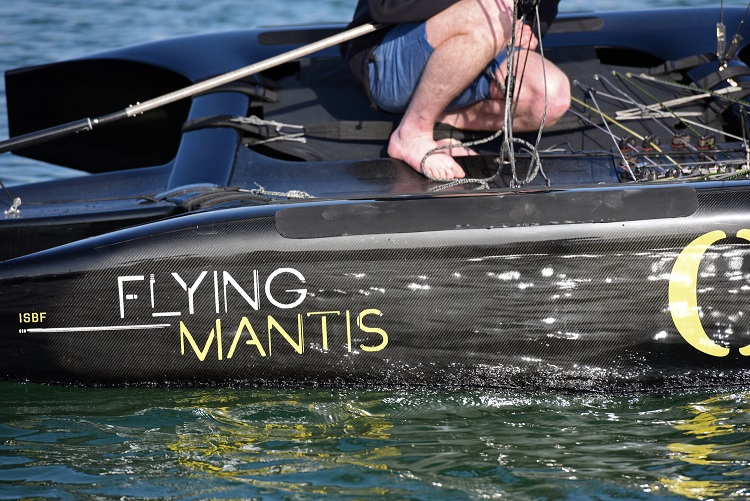
The Hulls
The 3 hulls are quick and easy to assemble, and are extremely light so less power is needed to drive the Flying Mantis forward. A relatively flat underside minimises time in the water, generating hydrodynamic lift. The U-shaped hull maximises displacement as the boat drops off the foils.
The hulls are an epoxy sandwich carbon construction. Hull colour is customisable.
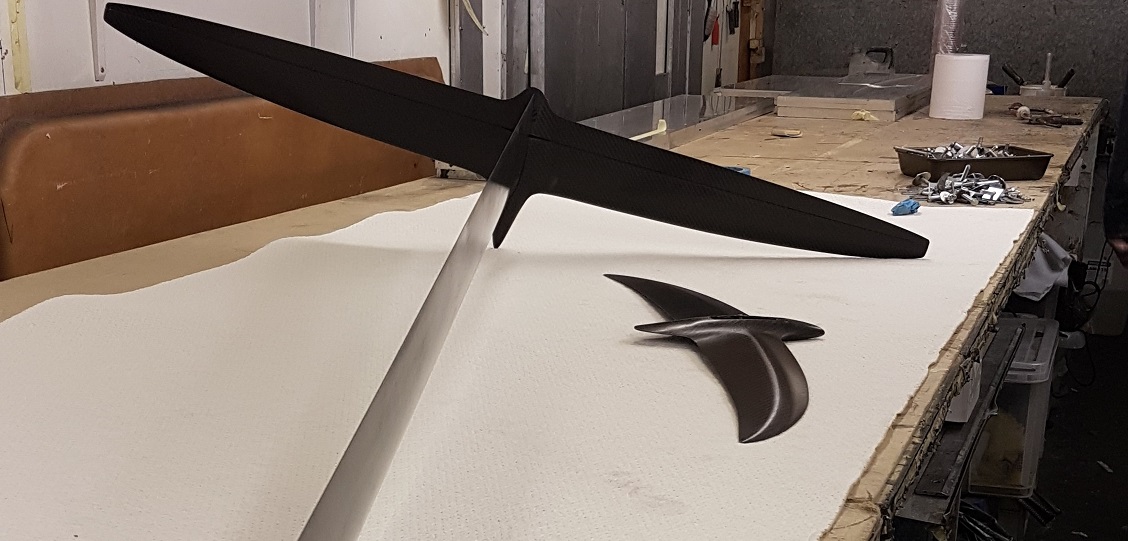
The Foils
The central and rudder T-foils can be lifted to help launch/recover from a beach. The control wand is attached to the end of a bowsprit, well forward of the central foil and close to the water. Being forward enables control of the pitch and ride height, and eliminates flow distortion from the central foil.
The twist-grip tiller controls the angle of the rudder T-foil, giving positive lift upwind and negative lift downwind, (less chance of pitchpoling).
11.2m²
Total sail area
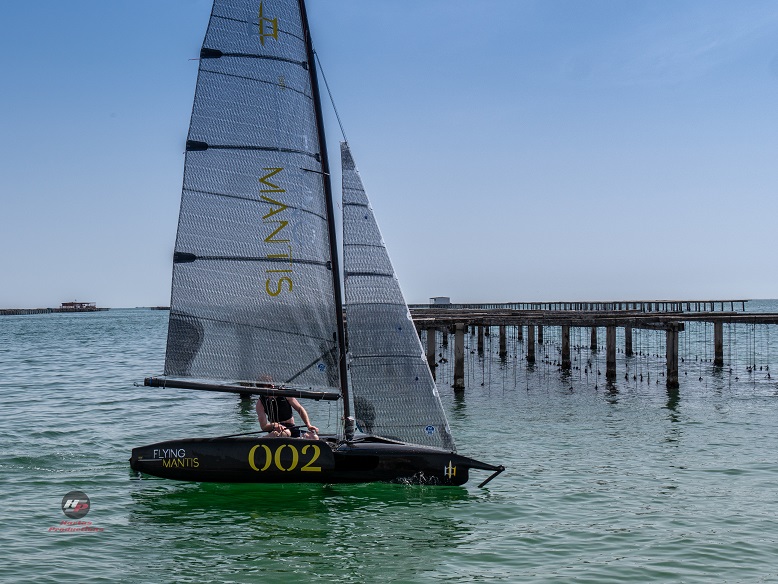
The Sails
Designed in conjunction with North Sails.
The addition of a jib to the main helps to keep the centre of effort low and balanced.
2.5m
Outrigger length
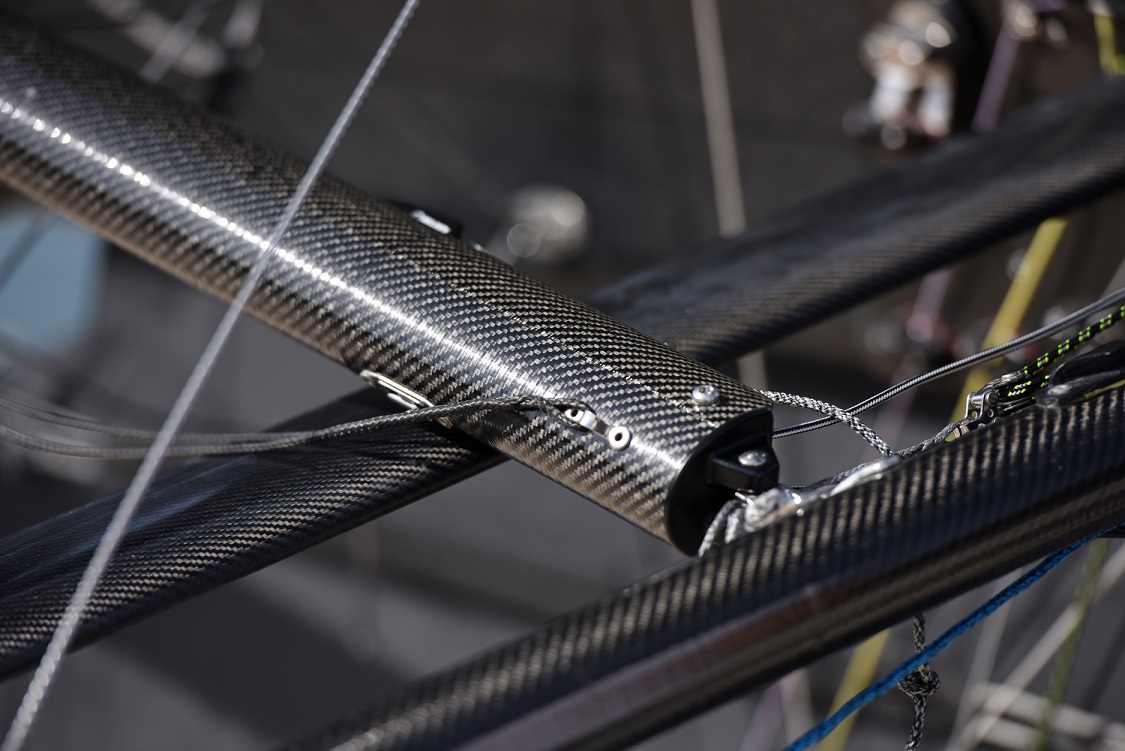
The Rig
The rigging is designed to be set-up and dismantled as quickly as possible. For example, the trampolines are partly secured using velcro fixings which are simple but effective. The idea of simplicity extends to the layout of the sheets and lines, and the use of a Gnav instead of a kicker/vang, helping to keep the deck clear.
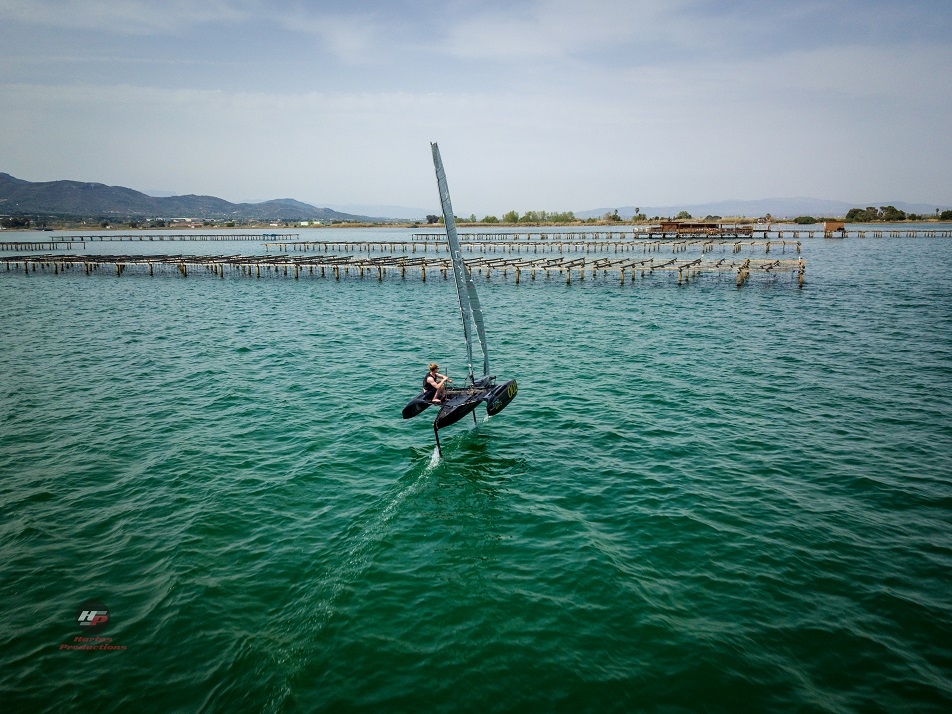
Safety
Read this. No, really read this.
“The challenge of sailing is knowing your limitations and being able to judge when you are exceeding them” Martin Kenny, Tynemouth lifeboat.
Follow the guidance on safe sailing and make sure you are prepared. Do not go sailing if no-one knows where you are and you have no means of rescue. The Flying Mantis is a performance craft. Wear protective clothing. Have fun.
The Boat
AWARD WINNING BOAT THAT’S TWICE THE FUN
Airborne foiling or sailing with a daggerboard.
14ft

Imagine
Foiling is a sport that is here to stay. Foiling has been around for years but until now it helped to be an expert sailor and not too large if you wanted to succeed. The Flying Mantis is designed to be sailed with a conventional daggerboard that can be swapped for a central T-foil, to go foiling. Why not progress from one to the other?
…and it’s fun, even if it’s not an ideal day for foiling.
25kg
Approx central hull weight

Portable
The central hull weighs around 25kg plus removable outriggers at 12.5kg each.
The Flying Mantis is designed to be rigged quickly. The outriggers can be fitted or derigged without taking down the mast. The boat can be towed behind a car with the hulls still assembled. It doesn’t need to live in a dinghy park, which makes it easier to sail somewhere different each day.
DBS

Sailing with a Daggerboard (displacement / mode archimédien)
A great boat that any sailor can enjoy. It comes with a lift-up rudder and a central daggerboard.
This boat has all the advantages of lightweight carbon hulls, mast and boom that result in high performance and forgiving multihull sailing.
Airborne Foiling
Everything from the daggerboard sailing (DBS) version but with replacement central and rudder T-foils and a foiling system that connects a control wand at the front of the bowsprit.
Designed to provide early take-off at lower boat speeds enabling more fun in lighter winds.
If the sailing conditions are not good for foiling, the Flying Mantis is still great fun as a conventional performance trimaran.

The Hulls
The 3 hulls are quick and easy to assemble, and are extremely light so less power is needed to drive the Flying Mantis forward. A relatively flat underside minimises time in the water, generating hydrodynamic lift. The U-shaped hull maximises displacement as the boat drops off the foils.
The hulls are an epoxy sandwich carbon construction. Hull colour is customisable.

The Foils
The central and rudder T-foils can be lifted to help launch/recover from a beach. The control wand is attached to the end of a bowsprit, well forward of the central foil and close to the water. Being forward enables control of the pitch and ride height, and eliminates flow distortion from the central foil.
The twist-grip tiller controls the angle of the rudder T-foil, giving positive lift upwind and negative lift downwind, (less chance of pitchpoling).
11.2m²
Total sail area

The Sails
Designed in conjunction with North Sails.
The addition of a jib to the main helps to keep the centre of effort low and balanced.
2.5m
Outrigger length

The Rig
The rigging is designed to be set-up and dismantled as quickly as possible. For example, the trampolines are partly secured using velcro fixings which are simple but effective. The idea of simplicity extends to the layout of the sheets and lines, and the use of a Gnav instead of a kicker/vang, helping to keep the deck clear.

Safety
Read this. No, really read this.
“The challenge of sailing is knowing your limitations and being able to judge when you are exceeding them” Martin Kenny, Tynemouth lifeboat.
Follow the guidance on safe sailing and make sure you are prepared. Do not go sailing if no-one knows where you are and you have no means of rescue. The Flying Mantis is a performance craft. Wear protective clothing. Have fun.
The Boat
AWARD WINNING BOAT THAT’S TWICE THE FUN
Airborne foiling or sailing with a daggerboard.
14ft

Imagine
Foiling is a sport that is here to stay. Foiling has been around for years but until now it helped to be an expert sailor and not too large if you wanted to succeed. The Flying Mantis is designed to be sailed with a conventional daggerboard that can be swapped for a central T-foil, to go foiling. Why not progress from one to the other?
…and it’s fun, even if it’s not an ideal day for foiling.
Portable
The central hull weighs around 25kg plus removable outriggers at 12.5kg each.
The Flying Mantis is designed to be rigged quickly. The outriggers can be fitted or derigged without taking down the mast. The boat can be towed behind a car with the hulls still assembled. It doesn’t need to live in a dinghy park, which makes it easier to sail somewhere different each day.
25kg
Approx central hull weight

DBS

Sailing with a Daggerboard (displacement / mode archimédien)
A great boat that any sailor can enjoy. It comes with a lift-up rudder and a central daggerboard.
This boat has all the advantages of lightweight carbon hulls, mast and boom that result in high performance and forgiving multihull sailing.
Airborne Foiling
Everything from the daggerboard sailing (DBS) version but with replacement central and rudder T-foils and a foiling system that connects a control wand at the front of the bowsprit.
Designed to provide early take-off at lower boat speeds enabling more fun in lighter winds.
If the sailing conditions are not good for foiling, the Flying Mantis is still great fun as a conventional performance trimaran.

The Hulls
The 3 hulls are quick and easy to assemble, and are extremely light so less power is needed to drive the Flying Mantis forward. A relatively flat underside minimises time in the water, generating hydrodynamic lift. The U-shaped hull maximises displacement as the boat drops off the foils.
The hulls are an epoxy sandwich carbon construction. Hull colour is customisable.
The Foils
The central and rudder T-foils can be lifted to help launch/recover from a beach. The control wand is attached to the end of a bowsprit, well forward of the central foil and close to the water. Being forward enables control of the pitch and ride height, and eliminates flow distortion from the central foil.
The twist-grip tiller controls the angle of the rudder T-foil, giving positive lift upwind and negative lift downwind, (less chance of pitchpoling).

11.2m²
Total sail area

The Sails
Designed in conjunction with North Sails.
The addition of a jib to the main helps to keep the centre of effort low and balanced.
The Rig
The rigging is designed to be set-up and dismantled as quickly as possible. For example, the trampolines are partly secured using velcro fixings which are simple but effective. The idea of simplicity extends to the layout of the sheets and lines, and the use of a Gnav instead of a kicker/vang, helping to keep the deck clear.
2.5m
Outrigger length


Safety
Read this. No, really read this.
“The challenge of sailing is knowing your limitations and being able to judge when you are exceeding them” Martin Kenny, Tynemouth lifeboat.
Follow the guidance on safe sailing and make sure you are prepared. Do not go sailing if no-one knows where you are and you have no means of rescue. The Flying Mantis is a performance craft. Wear protective clothing. Have fun.
The Boat
AWARD WINNING BOAT THAT’S TWICE THE FUN
Airborne foiling or sailing with a daggerboard.
14ft

Imagine
Foiling is a sport that is here to stay. Foiling has been around for years but until now it helped to be an expert sailor and not too large if you wanted to succeed. The Flying Mantis is designed to be sailed with a conventional daggerboard that can be swapped for a central T-foil, to go foiling. Why not progress from one to the other?
…and it’s fun, even if it’s not an ideal day for foiling.
Portable
The central hull weighs around 25kg plus removable outriggers at 12.5kg each.
The Flying Mantis is designed to be rigged quickly. The outriggers can be fitted or derigged without taking down the mast. The boat can be towed behind a car with the hulls still assembled. It doesn’t need to live in a dinghy park, which makes it easier to sail somewhere different each day.
25kg
Approx central hull weight

DBS

Sailing with a Daggerboard (displacement / mode archimédien)
A great boat that any sailor can enjoy. It comes with a lift-up rudder and a central daggerboard.
This boat has all the advantages of lightweight carbon hulls, mast and boom that result in high performance and forgiving multihull sailing.
Airborne Foiling
Everything from the daggerboard sailing (DBS) version but with replacement central and rudder T-foils and a foiling system that connects a control wand at the front of the bowsprit.
Designed to provide early take-off at lower boat speeds enabling more fun in lighter winds.
If the sailing conditions are not good for foiling, the Flying Mantis is still great fun as a conventional performance trimaran.

The Hulls
The 3 hulls are quick and easy to assemble, and are extremely light so less power is needed to drive the Flying Mantis forward. A relatively flat underside minimises time in the water, generating hydrodynamic lift. The U-shaped hull maximises displacement as the boat drops off the foils.
The hulls are an epoxy sandwich carbon construction. Hull colour is customisable.
The Foils
The central and rudder T-foils can be lifted to help launch/recover from a beach. The control wand is attached to the end of a bowsprit, well forward of the central foil and close to the water. Being forward enables control of the pitch and ride height, and eliminates flow distortion from the central foil.
The twist-grip tiller controls the angle of the rudder T-foil, giving positive lift upwind and negative lift downwind, (less chance of pitchpoling).

11.2m²
Total sail area

The Sails
Designed in conjunction with North Sails.
The addition of a jib to the main helps to keep the centre of effort low and balanced.
The Rig
The rigging is designed to be set-up and dismantled as quickly as possible. For example, the trampolines are partly secured using velcro fixings which are simple but effective. The idea of simplicity extends to the layout of the sheets and lines, and the use of a Gnav instead of a kicker/vang, helping to keep the deck clear.
2.5m
Outrigger length


Safety
Read this. No, really read this.
“The challenge of sailing is knowing your limitations and being able to judge when you are exceeding them” Martin Kenny, Tynemouth lifeboat.
Follow the guidance on safe sailing and make sure you are prepared. Do not go sailing if no-one knows where you are and you have no means of rescue. The Flying Mantis is a performance craft. Wear protective clothing. Have fun.

